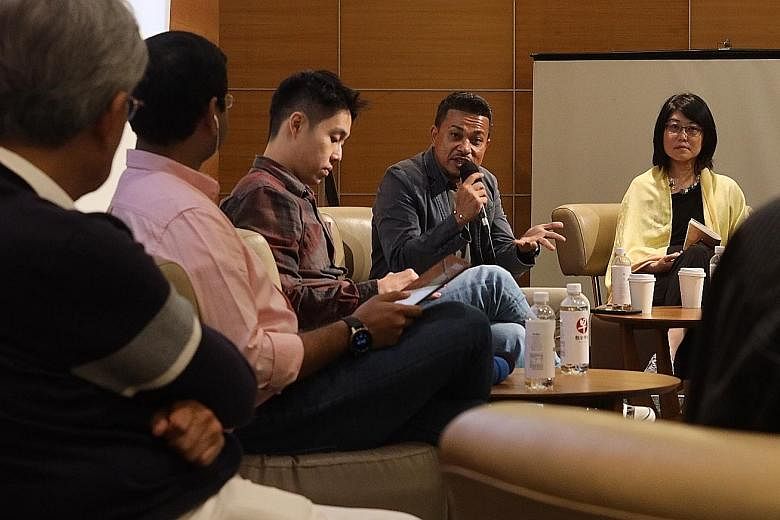Creating toolkits or guidelines and a shared understanding of key concepts to talk about race, ethnicity and religion are vital for these conversations to take place in a manner that unites rather than divides people, said a panel organised by Chinese-language publication Lianhe Zaobao on Saturday.
The session on "Race and Us" was organised in conjunction with Lianhe Zaobao's ongoing series of reports under the same topic, which examines the past, present and future of ethnic relations in Singapore.
In her opening remarks, sociologist Teng Siao See said Singaporeans will have to work through the possible disconnect or tension between concepts and terms that are cited, and their lived experience or daily encounters.
"Terms like 'critical race theory', 'Chinese privilege', 'Western importation' are important to discuss, as we can explore complexities, find connections and draw parallels," she said. "However, sometimes conceptual debates take precedence over lived experience, pushes it into the back seat and (the lived experience) gets lost." She said Singaporeans needed to get some of these daily interactions back into the discourse on race.
Dr Teng, assistant dean of strategic engagement at the National Institute of Education, said sharing stories about ethnic relations would help make discussions more accessible to the wider public.
Fellow panellist Bernard Menon, who is executive director of the Migrant Workers' Centre at the National Trades Union Congress, echoed her sentiment during the discussion, which was moderated by Mr Yap Pheng Hui, Lianhe Zao-bao's commentary editor.
Mr Menon said many Singaporeans find "we can't carry on the conversation because we don't have the language". He added that Singaporeans would build up such conceptual language if they deemed conversations on racial and ethnic relations as important enough.
However, he cautioned against using terms like Chinese privilege as accusations, saying: "In some conversations, people have thrown the words out to halt it, to get their last word in. Language like that, that can be weaponised, we should stay very far away from."
Other aspects of constructive conversations were also broached.
Mr Mohamed Irshad, founder of youth inter-faith initiative Roses of Peace and a former Nominated MP (NMP), said a four-step toolkit that his initiative adopts when facilitating such conversations advises suspending judgment, talking sensitively, active listening and respecting opinions.
He also said recent incidents of racial prejudice here are a cause for concern. "We are lacking unity today. It is not just the absence of denigration and more than law enforcement, which can only remove hatred but not add empathy."
The discussion then took an introspective turn, prompted by a question from moderator Mr Yap, as Mr Menon and Mr Irshad shared some personal experiences of bias.
-
Zaobao video discusses race
-
As part of its series exploring race relations in Singapore, Lianhe Zaobao has published a video based on interviews with nine Singaporeans of different backgrounds about their views on race and racism here.
The 20-minute video is narrated in Mandarin and has English subtitles.
The video was shared by Prime Minister Lee Hsien Loong on Facebook, who noted it was an open and frank discussion, and a timely one.
"With Racial Harmony Day around the corner, I hope we will examine our own behaviours and place ourselves in others' shoes, to better appreciate how others may feel," he wrote.
"We cannot take racial harmony in Singapore for granted. Racial issues are always sensitive," he said.
"But as these nine interviewees show, we can have honest and civil conversations and bridge understanding without being offensive, or getting defensive. It is an encouraging sign that we can build a more cohesive, yet diverse society together."
The video was also shared by Leader of the Opposition Pritam Singh, who wrote: "An important ingredient in addressing discussions on race/racism or even having a conversation about them is to put oneself in the other person's shoes - the direction of this video and the tone of the conversations/views, encourage us to do so."
Mr Menon, who is Indian-Chinese, chose to recount a positive story. "I studied Chinese as my second language during junior college, which confuses some people. In the first class, my Chinese teacher refused to go ahead with the class until those who didn't take Chinese all left. She assumed I didn't study it," he said.
However, she immediately went out of her way to apologise and make him feel comfortable upon realising her mistake, he added. "She didn't have to but still went ahead, and this had an invigorating effect as a minority seeking to find his way in a majority space." It was an instance where no negative intention was immediately apparent, he said.
Mr Irshad then recounted an incident that happened while he was an NMP. He had got in a lift with a Chinese woman, who then walked out of the lift swiftly, after making eye contact and exhibiting visible discomfort at his presence.
"It's an anomaly that's impactful for those who receive it, to remember for years to come," he said.
The other two panellists - author and senior grassroots volunteer Sim Piak How and researcher Donovan Choy - spoke about the risks of social media driving polarisation along lines of race.
Speaking in Mandarin, Mr Sim observed that policies instituted in the wake of the racial riots of the 1960s seemed to keep the peace until the rise of globalisation and the Internet. "This has led to the importation of many ideas into Singapore, leaving our understanding of race relations in flux. Many disputes - both individual and collective - were put on social media and went viral, leading race issues to come to the forefront of the national consciousness," he said
Agreeing, Mr Choy, a research fellow at think-tank Adam Smith Centre, noted that social media conversations about race tend to be split along two factions: one denying or downplaying racism, and the other claiming every social ill in Singapore can be analysed through the lens of racism. "Both sides do a disservice to minorities," he said. Nonetheless, he said, members of a racial majority will always get to go out into society and interact with it without the worries minorities face.
Dr Teng also spoke of the tension between giving minorities a vocabulary to explore their experiences, particularly of negative bullying, and potentially attaching ethnic groups to a stigmatising label.
"It is not so much whether the term or concept is imported, but how we use it - and if there are limitations, how we address it with historical contextualisation, a lot of exchanges and building consensus," she said in response to a question from the audience about imported concepts. "To move from conflict avoidance to talking about (racial and ethnic relations), we must allow some degree of constructive discomfort, not destructive discomfort," she said.


